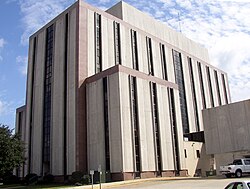Tuscaloosa County, Alabama | |
|---|---|
 Tuscaloosa County Courthouse in Tuscaloosa | |
 Location within the U.S. state of Alabama | |
 Alabama's location within the U.S. | |
| Coordinates: 33°12′23″N87°32′05″W / 33.2065°N 87.5346°W | |
| Country | |
| State | |
| Founded | February 6, 1818 [1] |
| Named after | Tuskaloosa |
| Seat | Tuscaloosa |
| Largest city | Tuscaloosa |
| Area | |
• Total | 1,351 sq mi (3,500 km2) |
| • Land | 1,322 sq mi (3,420 km2) |
| • Water | 30 sq mi (78 km2) 2.2% |
| Population (2020) | |
• Total | 227,036 |
• Estimate (2024) | 241,212 |
| • Density | 171.7/sq mi (66.31/km2) |
| Time zone | UTC−6 (Central) |
| • Summer (DST) | UTC−5 (CDT) |
| Congressional districts | 4th, 7th |
| Website | www |
| |
Tuscaloosa County is a county in the northwest-central portion of the U.S. state of Alabama and is the center of commerce, education, industry, health care, and entertainment for the region.
Contents
- History
- Early settlement
- Civil War and Reconstruction
- Civil Rights era
- 2000 to Present
- Geography
- Demographics
- 2020 census
- 2010 census
- 2000 census
- Culture
- Housing
- Recreation
- Entertainment
- River market
- Museums & The Arts
- College Sports
- Sports Leagues & Wellness
- Economy
- Major Employers
- Workforce
- Emerging Industries
- Education
- Higher Education
- Primary and secondary Education
- Government and politics
- Transportation
- Major highways
- Toll Roads/Bridges
- Transit
- Rail
- Airports & Cargo Facilities
- Waterway Access
- Communities
- Cities
- Towns
- Census-designated places
- Other unincorporated communities
- Ghost towns
- See also
- References
- External links
As of the 2020 census, its population was 227,036, making it the fifth-most populous county in Alabama. [2] The county seat and largest city is Tuscaloosa. Tuscaloosa County is part of the Tuscaloosa, AL Metropolitan Statistical Area, which also includes Hale and Pickens counties. The community gained international attention in 1993 when it landed Mercedes-Benz's first North American assembly plant, and as of 2021, the company employs over 4,000 people at the facility. Even so, Tier-1 research university the University of Alabama remains the county's largest employer and dominant economic and cultural engine.


